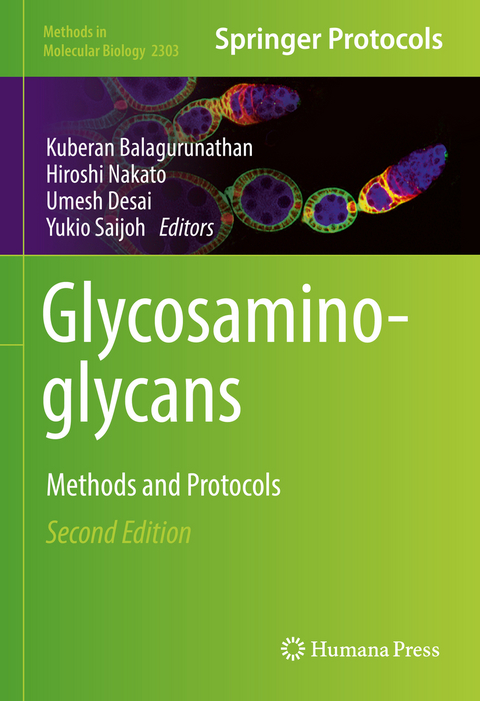
Glycosaminoglycans
Springer-Verlag New York Inc.
978-1-0716-1397-9 (ISBN)
Cutting-edge and authoritative, Glycosaminoglycans: Methods and Protocols, Second Edition is a valuable experimental manual for practicing researchersincluding graduate and post-doctoral fellows, and provides them with the latest methodologies and practical tips to overcoming barriers in understanding the chemistry and biology of GAGs.
One-Pot Enzymatic Synthesis of Heparin from N-Sulfoheparosan.- Solution NMR Spectroscopy for Characterizing Protein-Glycosaminoglycan Interactions.- Metabolic Labeling of Proteoglycans and Analysis of Their Synthesis and Sorting in Filter-Grown and Polarized Epithelial Cells.- Fluorous-Tag Assisted Synthesis of GAG-Like Oligosaccharides.- Aqueous Molecular Dynamics for Understanding Glycosaminoglycan Recognition by Proteins.- A Non-Radioactive Method to Measure Hyaluronan Synthase Activity.- A Glycoproteomic Approach to Identify Novel Proteoglycans.- Analysis of Protein-Glycosaminoglycan Interactions using Traveling Wave Ion Mobility Mass Spectrometry.- Ascidian (Chordata-Tunicata) Glycosaminoglycans: Extraction, Purification, Biochemical, and Spectroscopic Analysis.- Quantitative Disaccharide Profiling of Glycosaminoglycans from Two Different Preparations by PMP and Deuterated PMP Labeling.- Preparation and Characterization of Heparan Sulfate Derived Oligosaccharides to Investigate Protein-GAG Interaction and HS Biosynthesis Enzyme Activity.- Heparan Sulfate Structure: Methods to Study N-sulfation and NDST Action.- Methods for the Production of Recombinant Heparosan: A Critical Heparin Precursor, from Non-Pathogenic E.coli Strains.- De novo Sequencing of Heparin/Heparan Sulfate Oligosaccharides by Chemical Derivatization and LC-MS/MS.- Production and HPLC-Based Disaccharide Analysis of Xyloside-Primed Glycosaminoglycans.- Nuclear Magnetic Resonance Methods in Structural Characterization of Glycosaminoglycans.- Aggrecan: Approaches to Study Biophysical and Biomechanical Properties.- Chromatographic Molecular Weight Measurements for Heparin: Its Fragments and Fractions, and Other Glycosaminoglycans.- Mass Spectrometric Methods for the Analysis of Heparin and Heparan Sulfate.- Affinity Purification of Glycosylphosphatidylinositol-Anchored Proteins by Alpha-Toxin.- Thermodynamic Affinity and Nature of Forces Defining Glycosaminoglycan: Protein Systems Using Fluorescence Spectroscopy.- Isolation and Characterization of Heparan Sulfate Containing Amyloid Precursor Protein Degradation Products.- Chemical Approaches to Prepare Modified Heparin and Heparosan Polymers for Biological Studies.- Glycosaminoglycan Quality Control by Monosaccharide Analysis.- Characterizing Thermodynamics of Protein-Glycosaminoglycan Interactions using Isothermal Titration Calorimetry.- Automated Synthesis of Chondroitin Sulfate Oligosaccharides.- Capillary Electrophoretic Analysis of Isolated Sulfated Polysaccharides to Characterize Pharmaceutical Products.- Preparation of Isotope Enriched Heparan Sulfate Precursors for Structural Biology Studies.- Methods for Measuring Exchangeable Protons in Glycosaminoglycans.- Advances in Studying Glycosaminoglycan–Protein Interactions Using Capillary Electrophoresis.- anexVis: ATranscriptome Tool to Visualize Organ/Tissue-Specific Glycosaminoglycan Biosynthetic and Catabolic Pathways in Human Health and Diseases.- Molecular Genetic Techniques for the Proteoglycan Functions in Drosophila.- Measuring Sulfatase Expression and Invasion in Glioblastoma.- Analyzing the Role of Heparan Sulfate Proteoglycans in Axon Guidance In Vivo in Zebrafish.- Regulation of 3-O-Sulfation of Heparan Sulfate during Transition from the Naïve to the Primed State in Mouse Embryonic Stem Cells.- Analysis of Human Hyaluronan Synthase Gene Transcriptional Regulation and Downstream Hyaluronan Cell Surface Receptor Mobility in Myofibroblast Differentiation.- Methods to Analyze the Effect of Diet-Derived Metabolites on Endothelial Inflammation and Cell Surface Glycosaminoglycans.- Assays for Evaluation of Substrates for and Inhibitors of β-1,4-Galactosyltransferase 7.- Enzymatic Alteration of ECM to Explore Muscle Function and Motor Control of a Learned Behavior.- Procedures to Evaluate the Role of Heparan Sulfate in the Reactivity of Resistance and Conductance Arteries Ex Vivo.- Computerized Molecular Modeling for Discovering Promising Glycosaminoglycan Oligosaccharides that Modulate Protein Function.- Imaging Glycosaminoglycan Modification Patterns In Vivo.- Isolation and Purification of Versican and Analysis of Versican Proteolysis.- Identification of Cell Autonomous and Non-Cell Autonomous Functions of Heparan Sulfate Glycosaminoglycan Chains by Creating Chimeric Mouse Embryos.- Methods for Assessing the Effects of Xylosides on Angiogenesis.- Role of HSPGs in Systemic Bacterial Infections.- Generation of Drosophila Heparan Sulfate Mutant Cell Lines from Existing Fly Strains.- Application of a Mutant Cell Library to Determine the Structure-Function Relationship of Heparan Sulfate in Facilitating FGF-FGFR Signaling.- Manipulation of Glycosaminoglycans using Synthetic Xylosides toStudy their Roles in Lung Branching Morphogenesis in Ex Vivo Lung Bud Culture System.- Informatics Ecosystems to Advance the Biology of Glycans.- Analysis of 3'-phosphoadenosine 5'-phosphosulfate Transporters: Transporter Activity Assay, Real-Time Reverse Transcription Polymerase Chain Reaction, and Immunohistochemistry.- Preparation of Nanosensors for Detecting the Activity of Glycosaminoglycan Cleaving Enzymes.- The Detection of Glycosaminoglycans in Pancreatic Islets and Lymphoid Tissues.- Histochemical Analysis of Heparan Sulfate 3-O-sulfotransferase Expression in Mouse Brain.- Mapping Proteoglycan Functions Using Novel Genetic Strategies.- Xyloside Derivatives as Molecular Tools to Selectively Inhibit Heparan Sulfate and Chondroitin Sulfate Proteoglycan Biosynthesis.- A Strategic Approach to Identification of Selective Inhibitors of Cancer Stem Cells.- Applications of Xylosides in the Manipulation of Stem Cell Niche to Regulate Human Neural Stem Cell Differentiation and Neurite Outgrowth.- Murine Models in the Evaluation of Heparan Sulfate-Based Anticoagulants.- Investigating the Roles of Heparan Sulfate Structures in Alpha-Synuclein Aggregation in Cell Culture Models.
| Erscheinungsdatum | 18.10.2021 |
|---|---|
| Reihe/Serie | Methods in Molecular Biology ; 2303 |
| Zusatzinfo | 114 Illustrations, color; 66 Illustrations, black and white; XXI, 829 p. 180 illus., 114 illus. in color. |
| Verlagsort | New York, NY |
| Sprache | englisch |
| Maße | 178 x 254 mm |
| Themenwelt | Naturwissenschaften ► Biologie ► Biochemie |
| Naturwissenschaften ► Biologie ► Zellbiologie | |
| Naturwissenschaften ► Chemie | |
| Schlagworte | Biomechanical properties • Biosynthetic enzymes • GAG oligosaccharides • Heparin • NMR approaches |
| ISBN-10 | 1-0716-1397-9 / 1071613979 |
| ISBN-13 | 978-1-0716-1397-9 / 9781071613979 |
| Zustand | Neuware |
| Informationen gemäß Produktsicherheitsverordnung (GPSR) | |
| Haben Sie eine Frage zum Produkt? |
aus dem Bereich


